A Hot Date
Last night Sweet Husband called on his way home from work and asked if I would like to go to a bronze pour with him. One of his co-workers at the jewelry store (who shall be known hereinafter as Nice Kim) also casts large bronze pieces as part of a family business that he runs with his father. If you've seen the huge Jayhawk in front of Strong Hall on campus, you know their work. A "pour" is the step in the process where the bronze is heated and "poured" into the mold.
I almost decided not to go. Standing around watching people play with hot metal (as punny as it may be) is not necessarily my idea of a hot date. But, in the end, I was persuaded, and I was glad that I went. Nice Kim and his family really make it into an event, and it was interesting to watch.

When we got there they were moving the molds into a sand pit. Sweet Husband explained that the molds are placed in the sand partly for safety reasons. If the molds should break or something should go wrong, the hot metal will be absorbed into the sand instead of spraying out onto people. The people in the picture are Nice Kim (down in the pit in blue) and John, the designer of the sculpture.

Sweet Husband was quickly put to work tamping the sand in tightly around the molds.

When they were done, the molds were almost completely buried.
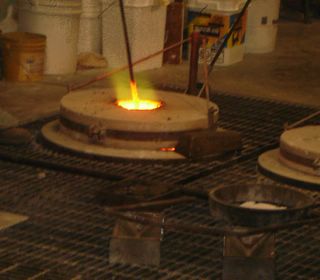
While they were getting the molds situated, an underground furnace was heating up a large crucible of bronze.

Before taking the crucible off the heat, everyone donned protective jackets, gloves, and face sheilds.

The crucible was lifted up with a tool that looked like a big set of salad tongs. Two people on each side steadied it, but the lifting power was partially provided by a chain hoist on the ceiling.

The crucible was then placed out onto the floor so that the temperature could be measured. To fill the mold properly, the metal needs to be about two-thousand degrees. Too cold and it might harden before it fills all the spaces, too hot and the structure of the metal won't be right.

Then, again with the help of the chain hoist, two people lifted the crucible up using a long handle. A third person used another pole to keep it all steady.
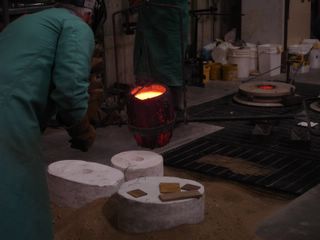
Then the entire team carefully moved the crucible over to the molds.

They carefully poured the hot bronze into the tops of the molds. I thought that it might be kind of gloopy, but the metal flowed out of the crucible just as easily as water would have.

Here you can see the whole team working.

They filled two molds first and then had to melt more metal in order to fill the third.
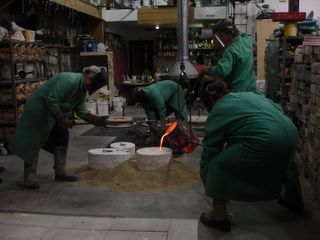
After waiting a few minutes for more bronze to melt, they filled the third mold.
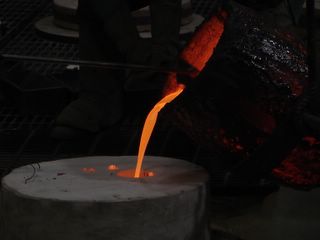
Sweet Husband says that a crucible is usually made from "a high temperature clay-silica mix, but it might have been graphite". (I don't think he's really sure!) Whatever it was, it was hot!
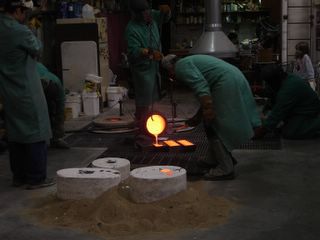
Once all the molds were full, Nice Kim poured the remaining metal into trays to make bronze ingots that could easily be used for something else later.
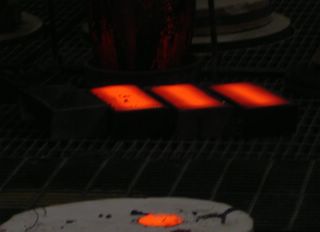
It made me think of really hot ice cubes.

The end result was three filled molds and three leftover ingots. I talked with the designer a little later and he said that the molds were for three of the legs of a twelve foot bronze deer that was going to live in Andover, Kansas, when it was all finished.

Once the work was over, it was time for fun. After a toast and introductions, one of Kim's daughters pulled out a basket full of popcorn. It turns out that the residual heat from the furnace makes a great campfire substitute.
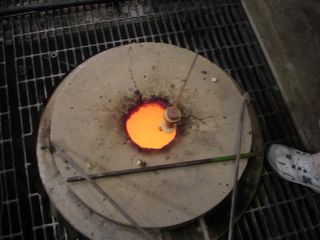
It takes a certain technique to properly cook this way though. In order to keep everything from falling off, the last piece on the stick had to be meat. If you wanted a slower cooked kabob, you could hold your stick just over the hole on top.
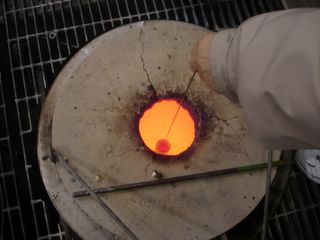
But who has that much patience? Sticking the kabob into the fire cooked it in seconds, and spinning the stick made neat "fireworks" as the grease caught on fire.





0 Comments:
Post a Comment
<< Home